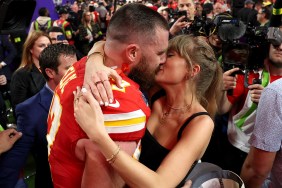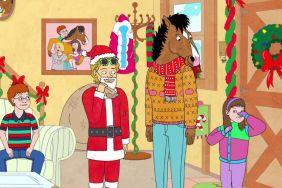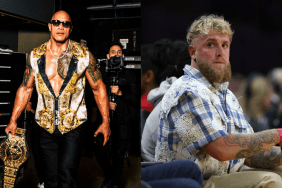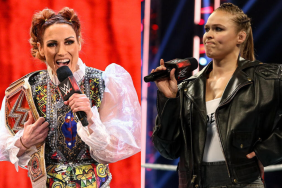Director Gore Verbinski is best known for launching one of the most successful franchises of the past ten years when he teamed with Johnny Depp’s Captain Jack Sparrow to make three “Pirates of the Caribbean” movies. Earlier this year, the filmmaker delved into the world of animation and produced Rango, one of the most innovative animated movies of the year.
It’s a Western, but its title character is a chameleon, also voiced by Johnny Depp, who has grown accustomed to his domesticated life living alone in a glass aquarium and putting on essentially one-lizard shows. An accident leaves Rango stranded out in the desert where he comes across the town of Dirt and its quirky inhabitants, so the quick-witted lizard finds himself having to use his skills at improvisation to gain the community’s trust, as well as getting actively involved in their desperate search for their most precious commodity, water.
Not to give away our Top 25, which we hope to have posted sometime next week, but Rango isn’t just one of the best animated movies we’ve seen this year but also one of the best movies, mainly due to the way Verbinski has put a creative spin on the Western genre with a vision that offers laughs and adventure while quickly making you forget you’re watching a bunch of talking animals. It’s the type of innovation we’ve come to expect from Pixar and DreamWorks Animation but in this case, Verbinski took an unconventional approach to make Rango by working with Industrial Light & Magic, who are primarily known as a visual effects house.
That’s one of the many things ComingSoon.net learned about when we sat down with the director last week for the following interview where we also got to touch a bit on his next movie, which reteams him with Johnny Depp for The Lone Ranger.
(Oddly, the film’s main competition in the animation category this year will probably be Steven Spielberg’s The Adventures of Tintin, and we also have an interview with him here.)
ComingSoon.net: I want to go back in time and ask about developing the character of Rango with John Logan and Johnny Depp, and just trying to get the general idea of the character. How did that come about and what was the process?
Gore Verbinski: This whole thing started with a premise, which is making a Western with creatures of the desert. Then, from that, it was a natural evolution to – this is before John Logan came on. I was kicking it around with David Shannon and John Carlos at a breakfast at Art’s Deli. I wrote this 12-page outline and sat on it for three years while I went off and made a couple other movies. In that outline, there was the sitting down and kind of saying, “Okay, well there needs to be an outsider, a protagonist. There needs to be a man with no name coming into town and what if he’s a lizard? Okay, if he’s a lizard, maybe he should be aquatic. If he’s aquatic, he should be a chameleon. If he’s a chameleon, he should be an actor. If he’s an actor, he should have issues.” So that’s the kind of step, then a really rudimentary beat sheet of the entire movie. After “Pirates 2,” I brought that to John Logan. He really latched onto this identity quest. John’s really a fan of the western, but he’s also incredibly well steeped in mythology and Homer and Shakespeare and he really kept us sort of dramaturgically honest. Jim Burkett, Head of Story, and I would sort of riff more on the absurdist humor, so it was a really good bashing out of the narrative.
CS: Had you worked with John Logan before?
Verbinski: He did a lot of work at DreamWorks when I was there. We’d never worked together, but we’ve kind of bumped into each other over time, and I just have always liked him. I knew he was a very, very good writer, but also just a really great guy to sort of collaborate with. I was frankly, very surprised that we talked to each other. He said, “We should find something to do together.” I said, “Well you probably don’t want to do it, but I’ve got this animated idea that I want to do.” I think as I was describing it, I think he sort of honed in on this sort of existential crisis of the protagonist, and I think once he found that way in he’s like, “I want to do this.” Then with Johnny, I was shooting two other films with him and I keep saying, “I’ve got the lizard project,” as we started calling it. I just said, “I want to do this animated movie. I’ve got this lizard. It’s a Western. He doesn’t know who he is. I would love for you…” Johnny was like, “Great, let’s do that. That sounds great.” So he really jumped in, a tremendous leap of faith; we had him at lizard I think. Even though he wasn’t there in the 18 months when we were kind of working the story reel, he was sort of present by virtue of… we’ve just worked so much together that the kind of whole thing was designed I think for what he does so well. I guess we talked a little bit about somewhere behind all of the silliness there’s this… “Well, in real life, if you’re a little Edward Scissorhands and a little Ed Wood and a little Jack Sparrow and all the others, how much room is there left for Johnny Depp? Who is Johnny Depp?” So I think that’s a little haunting, you know?

CS: Did you ever pitch it to Disney or DreamWorks Animation or did you always want to do it by yourself with ILM?
Verbinski: It was interesting because none of us had ever made an animated movie before, so we didn’t really know where to begin. John Logan actually said, “Before we go to a studio, why don’t we talk to Graham,” Graham King who he had worked with on “The Aviator.” John and I went in and talked to Graham. He’s like, “I don’t do animation.” We kind of were like, “Don’t worry. We’re going to work it out.” We convinced him to give us enough money to do the story reel, which we spent 18 months in my old house in the hills above Pasadena just with Crash McCreery and Dave Shannon and Eugene Yelchin and Jim Burkett, really seven of us in this house kind of just going to Trader Joes to get some hotdogs. Our line producer Adam Cramer was a sculptor, so he would start sculpting and we were just illustrating. Logan would come in with pages and then we would read them on microphone and we’d do all the voices. We’d cut it in Final Cut and put the drawings together, look at it, hate it, start again, do it again. There were guitars, we had a little studio there, so we’d write some songs. For a year and a half, it was really incredibly low-fi, incredibly cheap and it was probably the most fun I’ve ever had. We worked so hard and long walks and the guys playing foosball and then coming back to drawing. After all those “Pirate” films, it was really nice to kind of settle down and say, “We’re doing it. We’re not asking for permission. We’re not pitching it. We’re just going to go make this movie.” At the end of the 18 months, we had a story reel and we started to phase in conversations with ILM. We knew we were going to want to do this at ILM because I’ve done thousands of shots there and I know how and Tim and John and all those guys.
CS: So you did a story reel even before involving ILM…
Verbinski: Oh yeah. So, there was really three phases. There was 18 months for the reel, 20 days record with the actors and then another 18 months at ILM. We started to budget the story reel. I kind of felt like Fox had Blue Sky and Disney had Pixar and 100 other animated movies. I think Sony had their own animation division and Warner Brothers had Animal Logic. So I felt like Paramount was a good fit. Also, they had Nickelodeon, so it just seemed like they could perhaps market an animated movie, and they were doing a DreamWorks animated film. I called Brad Grey and asked him to come over and he kind of stumbled into this house through the laundry–the edit bay is in the laundry room–and he was like, “Where am I?” I said, “Just hang tight” and showed him all the art on the walls and played him the cut and said, “Johnny is in. We want to do this.” He took a little while thinking about it and he said, “Okay.”
CS: At any point, did any of you go, “Could this maybe be a little too weird or subversive for kids and it might make their heads explode?” Was that ever a factor or did you just want to make it and let its audience find it?
Verbinski: I would always start with, “This is weird and subversive and not necessarily for kids.” Those are my intro lines. “Okay, I just want you to know before you watch this.” That doesn’t mean that cut to three-and-a-half years later when we’re finished and it enters the view of the marketing department, that doesn’t mean that people aren’t concerned. I said this two-and-a-half years ago, “Guys, this is what we’re doing.” By then, it was too late to change it. It was not something Machiavellian going on. It was like, “Look, I think animation is not a genre. It’s a technique for telling a story. It can be so much more.” Frankly, the stuff that Pixar does is awesome. The stuff that Blue Sky and those guys do is amazing. Like, DreamWorks, I think it’s sated, that business model of, “Bring your six your old and come and it’ll be okay.” I think we would just be getting in line behind all of that and there’s no identity chasing. What they do so incredibly well…
CS: Which is kind of ironic, because many people are saying this is the best animated movie of the year, and people have been disappointed with the latest Pixar or “Happy Feet.” It’s just amazing that all these studios who do animation for a living have made movies that have not connected with people. Maybe you can’t tell from the box office, but if you talk to people who see the movie.
Verbinski: I think you’re keying into a totally different thing which is, it has to do with sequels. I think audiences ultimately want something new. I think the business model for a franchise is such that it’s very low risk because you have data and studios love data.

CS: I was talking to Sam Shepard and he was talking about how as a kid, he loved Westerns, and in some ways, this is a movie that can get kids into Westerns, even if it’s a bit more challenging. But maybe they can watch this and like the types of stories and characters.
Verbinski: It depends on the kid. I mean, when people talk about demographics, I kind of think of it more as sort of user profile. I don’t care if you’re six years old or 90 years old, I mean, there are kids who will love it and there are kids who won’t, you know? I think if we find the champions, there’s a business model for that, too. Amazon makes that work, right?
CS: But as you went into this, you knew that you weren’t necessarily making a kids movie.
Verbinski: Look, the one thing that we knew is we had to do a story reel. What Pixar does is very, very sound. We just did it on a shoestring because once we started rendering it, I wanted to be able to afford to go to ILM. We just did the front end on a shoestring, but we spent just as much time and just as many iterations. On the one hand, we were very conventional on the front end, but slightly unconventional in the audio record out of fear of “Why give up a technique that we use in live action, which is basically put your actors together and have them react to one another?” I mean, I was foreign to not do that. Then using a visual fx house to complete the film. I’ve gotta say migrating from this mentality of the shot, which is what we do when we’re working on Davy Jones or whatever, it’s like, “Here are the plates. Here is the three shots you’re working on out of context,” to the mentality of holistic, “We’re making an entire film,” spending time with Hal and the animators, and saying, “Look, don’t think about your shot. Think about the reaction. Where are we coming from? He’s coming in the room. Where has he been? What’s his emotional state as he enters this room when he says that line? He’s lying, but he also is hoping that people are buying it so that little muscle spasm under the eye at the end of the line becomes very significant.” I gotta say, those animators were incredibly starved for – I mean, they’re basically my cast at that point. You’re directing them. I think they’re incredibly talented, and normally doing a CGI tumbling bus exploding or animating a giant robot or something. So to get into really nuanced facial performances and to talk holistically about, not a series of shots, but an entire narrative.
CS: It gave them a chance to work with more developed characters than the ones they normally have a chance to animate.
Verbinski: Yeah, exactly. Not only working with characters, but also working on an entire narrative and saving this stuff for this third act and don’t afraid to be still. Don’t animate everything. Stop for a second. We kind of got underneath the whole kind of corporate… and just got artist to artist and became a real tight knit family. We spent a lot of time together.
CS: Who is easier to direct, actors or animators? Did animators have their own set of issues that you had to figure out how to talk them down from?
Verbinski: Honestly, every person, every individual has a process, and my philosophy, whether it’s an actor or an animator, is you try to understand the process that person has so you can get the most out of them, but I think you have to sort of manipulate that process with honesty. I think you can never ever lie ever. If you don’t know, say, “I don’t know.”
CS: One of the things I never got to ask you about before, about the music background and how you bring that to the table and working with Hans, having done four movies with him now. I was curious how you bring your own music to the table when working with Hans. You mentioned having written some songs beforehand, as well.
Verbinski: Yeah, I mean, Hans is very busy, so we just started writing songs. When we were in pre-production, Hans came in and helped the song. Actually, the main theme for “Rango” was written by some friends of mine from junior high school. We used to play in a band. They wrote the song “Rango” as a parody. When I was thinking of a name for the character I called up my friends and said, “Do you mind if I use the song that you guys wrote in junior high for the theme song?” They were completely stoked. Then, we had Ken Carmen who’s our music editor went out and recorded a few things. Jim and I sang a few melodies to the mariachias. Then, once Hans became available, he started writing some music and calling David Hidalgo from Los Lobos to come in. So it evolved and Arturo Sandoval came in to play trumpet, who is a monster, unbelievable. The music is really the most fun because it was animated and we had synched music as well. We had to get in front of it; we had to do some stuff very early in the process.

CS: Having finished this a while ago, how do you feel about doing more animation? Do you have any other stories where you feel it would be easier or better to do it with animation? What’s your mindset as far as doing another animated movie?
Verbinski: I’d like to some day. I mean, I think something completely different. Some deep-seated ideas that I think just have to sort of boil up and they’ll take a little time. I’m a big fan, I gotta say. I really enjoyed it. My respect for animators and animation directors has gone way, way up and it is just not something you can phone in. This idea of–at least for me personally–of being a live action director and saying, “I’m going to do an animated movie and I’m also going to do a live action movie at the same time,” I mean, you can’t. I mean, you gotta kind of go, “Okay, for three-and-a-half years, this is all I’m going to do and I’m going to focus on it every day.” So, I don’t know. I gotta say, I really enjoyed it. The downside is there are no gifts. Nothing happened in real time, and it’s very hard to remain intuitive and respond to something. You’re kind of trying to fabricate anomaly and flaw and the perception that there’s some uncertainty happening because this is really important for us to feel like if you were a tortoise and I’m a lizard that the cameraman’s here with a camera on his shoulder, and that I may turn my head and the focus may be late or you may say, “Oh, that’s different.” You could get up out of the chair and be surprised by it. So all that stuff is faked and is created, but yeah, we really tried to make the feeling that the whole thing could go off the rails at any moment because I think there’s slight palpable energy to that. I love a passionately flawed movie.
CS: I was kind of surprised when I learned you were doing “The Lone Ranger” because you’d think you got doing a Western out of your system with this, but I guess it just made you want to do another Western really soon. Was that your thinking when you took that or did you just like the character?
Verbinski: Yeah, those things were set in motion a long time ago. I’d worked on that script for about 18 months with Justin Haythe. So it’s different. It’s a Western, but it’s a completely different narrative and I just feel like I’ve got my hands on the stirring wheel, finally, in terms of having a story that I really… I think you have to be able to answer the question, “Why must you tell this story?” Otherwise, you’re going to be halfway through a movie and want to slit your wrists.
CS: I think when you made the first “Pirates” movies, a lot of people were shocked, first of all by what a big success it became. Do you find it’s very different now when you want to make a “Lone Ranger” movie? I would think people at the studios would be more trusting now that you have many hits. Or is it even harder to make movies like “The Lone Ranger,” when you know there’s so much baggage and expectations?
Verbinski: Yeah, it’s really nice to be the underdog. It’s really nice when people say, “They’re crazy. That’s never going to work. What do they think they’re doing?” That’s a great place to be. There’s something reassuring about (it). You feel like you’re doing your job if you’re making executives nervous. When they’re not nervous anymore then you start to get nervous like you’re doing something wrong or you’re not pushing it far enough or you’re not…
CS: I guess that must come from out of your punk background. I think there must be a little bit of that left in you…
Verbinski: Honestly, it’s just an endless education. So if you can reach for things you don’t know how to do, you wake up in the morning, and there’s more kick in your step and you’re leaning into every day because you’re like, “Wow, I don’t know how to do this. I’ve never done this before.” I think there’s a lesson coming off of sequels and the “Pirates.” As much as I love the character and the world and the concept of, “Wow, I get to make a pirate movie. How often do you get that opportunity in your life?” There is something once you move from the first one, from those expectations, to the next two where everybody kind of knows… There’s data. There’s data now. People know. I think it’s just nice to get away from that and get into something unknown.
Rango is out now on Blu-ray and DVD









